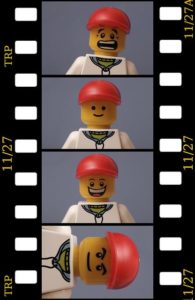Companies that use content marketing already know that the more gated content you have, the more content conversions you will get. In fact, in a recent study we ran at BrightInfo, we found out that for every 10% increase in your gated-to-free content ratio, your conversion rate will increase by 3.9%. (More data from this study will be in an eBook that’s coming.) That can mean a huge difference for your business.
But there’s a hidden problem there: companies now have way more content than premium online real estate on which to promote it. So the big question is: How do you get the right content to the right person?
The smart answer: By matching certain content items to certain audiences. When this is done on a group level it is called segmentation. When this is done on an individual level it is called personalization.
Defining “segmentation” and “personalization”
 Segmentation and personalization are two different aspects – and, some might say, different generations – of online marketing. Together they can help marketers deliver a very potent punch of engagement with anonymous site traffic – as they turn audience segmentation into a truly personal customer experience.
Segmentation and personalization are two different aspects – and, some might say, different generations – of online marketing. Together they can help marketers deliver a very potent punch of engagement with anonymous site traffic – as they turn audience segmentation into a truly personal customer experience.
Segmentation is knowing something about a group of people – typically, it’s their tendencies or behaviors derived from observed actions, averages and means within somewhat homogeneous groups. Marketers use rule-setting to cluster people together into these groups. It is mostly effective for known leads – as you very likely know something about these people. But even for anonymous site traffic, it’s certainly better than one-size-fits-all mass advertising, and it provides a sense that the marketer is actively doing something. Those are good things. Companies who use segmentation say it increases conversion rates by up to 30%.
Personalization means knowing something about a specific individual and usually involves inferring something meaningful about his or her interests in real time. This would be impossible to do by hand, but automation makes it possible, even for anonymous site traffic. But it also means that marketers have to relinquish some control to an algorithm – not an easy thing to do.
Our data at BrightInfo shows that companies who use content personalization increase conversion rates by up to 80%. What makes it more effective is the fact that most people (57%) feel good about providing personal information on a website, as long as it’s for their benefit and being used in responsible ways.
Can’t we all just get along and combine the two?
Well, we certainly can. Here’s how to do it with your content:
You are probably already using marketing personas. For example, if you’re a mortgage bank, you are likely to be dealing with first time home owners, real-estate investors and people who look to re-mortgage. Let’s use these three buyer personas, knowing that there can obviously be more.
Now, you have your pool of content – typically a weekly blog post, and 10-20 gated content items: your eBooks, webinars, etc. Let’s say your content team has 11 such items.
By using rule-setting segmentation only, we would choose a specific content item for each persona, or on each page.
By using content personalization, we would let an algorithm decide, based on textual relevance, user behavior, and conversion rates. It would be a one-to-one experience for the receiver.
The thing is, if you’re using segmentation only, we would be deciding what specific content item to offer each persona, regardless of what the visitor wants to read or watch. Knowing how fragmented the buyer journey is nowadays, that’s not an ideal offering for the prospect. If you’re using personalization, an algorithm would be making those choices, based on the buyer’s actions, without asking you what you want to promote. Reading relevant content is good for the prospect, but not as good as reading relevant content that you wanted the prospect to read. In addition, knowing how difficult it is to attribute leads in the age of nonlinear marketing funnels, marketers like to stay on top of first-touch attribution.
But perhaps the most important thing: by combining the segmentation and personalization, we can provide a dynamic experience – not a static one.
How to actually connect segmentation and personalization
Back to the mortgage bank: what if you can give your algorithm some guidelines in how to optimize its content offers? Wouldn’t that be magical? Well here’s how to do it:
- Make sure you have enough content to answer the interests of each buyer persona. How much is enough? 5-7 content items to each persona should suffice. Make sure they cover the range from the “Just looking” top-of-funnel prospect, to the mid-funnel “What’s the ROI?” lead, all the way to the “I’m ready to buy but have to decide between two vendors” bottom-funnel ready-to-close lead.
- If you don’t have enough content for each persona at each stage, get busy writing it. Since our marketers had only 11, we did some content production planning and kept all three personas in mind to make sure the new content provides each persona with a 360-degree, multi-stage solution.
- Now that we are content rich – hurray! – let’s assign six content items to each persona.
- Let’s double-check that our content baskets are ready and aligned with those three personas.
- Lastly, it’s time to configure the algorithm to choose the best content from that list, and from that list only.
That’s it! Now prospects will be engaged with the most relevant content … out of the content pool that you wanted them to read. So you are achieving a good mixture of listening to their online behavior without forgetting your personas – and delivering a dynamic, personalized experience on an individual basis.
Want to learn more about how to build and use buyer personas to enhance email personalization? Act-On’s free Buyer Persona Toolkit includes a 15-minute video and downloadable resources to make creating buyer personas easy.



